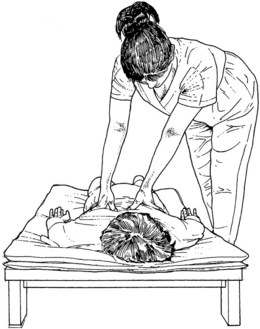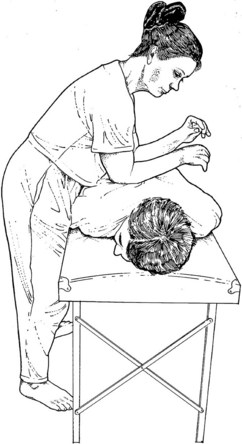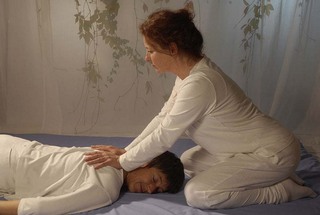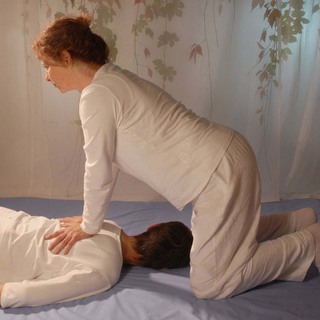CHAPTER 8 Working with Shiatsu 2
Basic techniques and tools
Contraindications
Before beginning to learn, we need to know when not to use Shiatsu.
Any kind of acute illness with fever is unsuitable for general Shiatsu treatment, since the fever is a sign that the body is already engaged in fighting off the infection, and should not be overloaded. Certain points, however, may help to speed recovery by eliminating the external pathogenic factor (see p. 140)
Shiatsu should be given with care in osteoporosis, for fear of damage to the bone. The same caution should be used in treating receivers who have had chemotherapy, for the same reason. High blood pressure is traditionally contraindicated, but this applies only to very hard and forceful pressure, which could damage the blood vessels. If only gentle Shiatsu techniques and relaxed penetration are used, Shiatsu can be soothing and beneficial in cases of high blood pressure.
Practical Basics
Floor, bed or chair?
If a receiver cannot lie on the floor, we must choose another treatment position. For elderly people the techniques traditionally performed with the receiver in a kneeling or sitting position on the floor can be modified for use in a chair. For situations where neither floor nor chair are suitable, the solution is a treatment couch which is the right height to allow us to apply pressure through straight arms while leaning forward from the hips, or a couch which can be raised or lowered by a foot pedal (Fig. 8.1).
Standard fixed height treatment couches make it very hard to work from our Hara, and unless we mostly use our elbows, it is difficult to use relaxed body weight (Fig. 8.2).
Clothed or unclothed?
One of Shiatsu’s great advantages as a therapy is that it can be given through clothes. This is not only for reasons of modesty, traditional in the Far East and particularly necessary when Shiatsu techniques stretch the receiver’s limbs into revealing positions; it is also relevant to Shiatsu practice. On hot days or in a warm room, giver or receiver can sweat, making the receiver’s skin too slippery for stretches or pressure. It can also feel unpleasant to receive Shiatsu from sweaty hands, and for this reason many practitioners use a cloth when working on the face or other uncovered areas.
More importantly, the focus of Shiatsu pressure is not the skin surface, but the deeper body structures and above all the Ki within the body. As students we are encouraged to feel the shape and tone of the receiver’s body through clothing, rather than uncovering areas ‘to feel them more easily’, since our sense of touch should not be distracted by the texture of the skin. Clothing can also be useful for observation diagnosis; to the eye of the experienced practitioner, the way clothing falls or creases can enhance rather than prevent her perception of the flow of the receiver’s Ki (see p. 323).
Shiatsu Techniques
One of the most important skills we can bring to our Shiatsu is an awareness of our:
1 Posture
Relaxation and comfort
To give good Shiatsu our body must be free of tension and we need to avoid any sense of deliberately applying pressure to our receiver’s body. We could imagine the experience as a dance between two people, rather than a process in which an active therapist applies thumb pressure to a passive patient. When we abandon our ideas of ‘doing something to’ the receiver and allow ourselves to relax and become part of a process, Ki flows through us both as if through two circuits joined to make one.*
The basic movement: crawling
Controlled use of body weight occurs naturally in crawling, as we shift our body weight gradually on to each limb in turn, while allowing the other three limbs to support us. In giving Shiatsu, this is the correct way to change the strength of our pressure; not by using our muscles to press harder or more lightly, but by continuing to ‘crawl’ and use body weight, only keeping more weight invested in our supporting knees and less in our hands when we need to use a lighter touch (Figs 8.3 & 8.4).
When we abandon our body to the floor’s support we can relax. Tension disappears from our shoulders and hips as we crawl – our body weight is naturally supported by the floor. This depends largely on the vertical position of our arms and thighs; they are at right angles to the floor. When giving Shiatsu, we should remember this and keep our body at an appropriate distance from the receiver, so that our body weight can meet the receiver’s body surface at right angles.
From crawling to use of Hara
Stay updated, free articles. Join our Telegram channel

Full access? Get Clinical Tree












